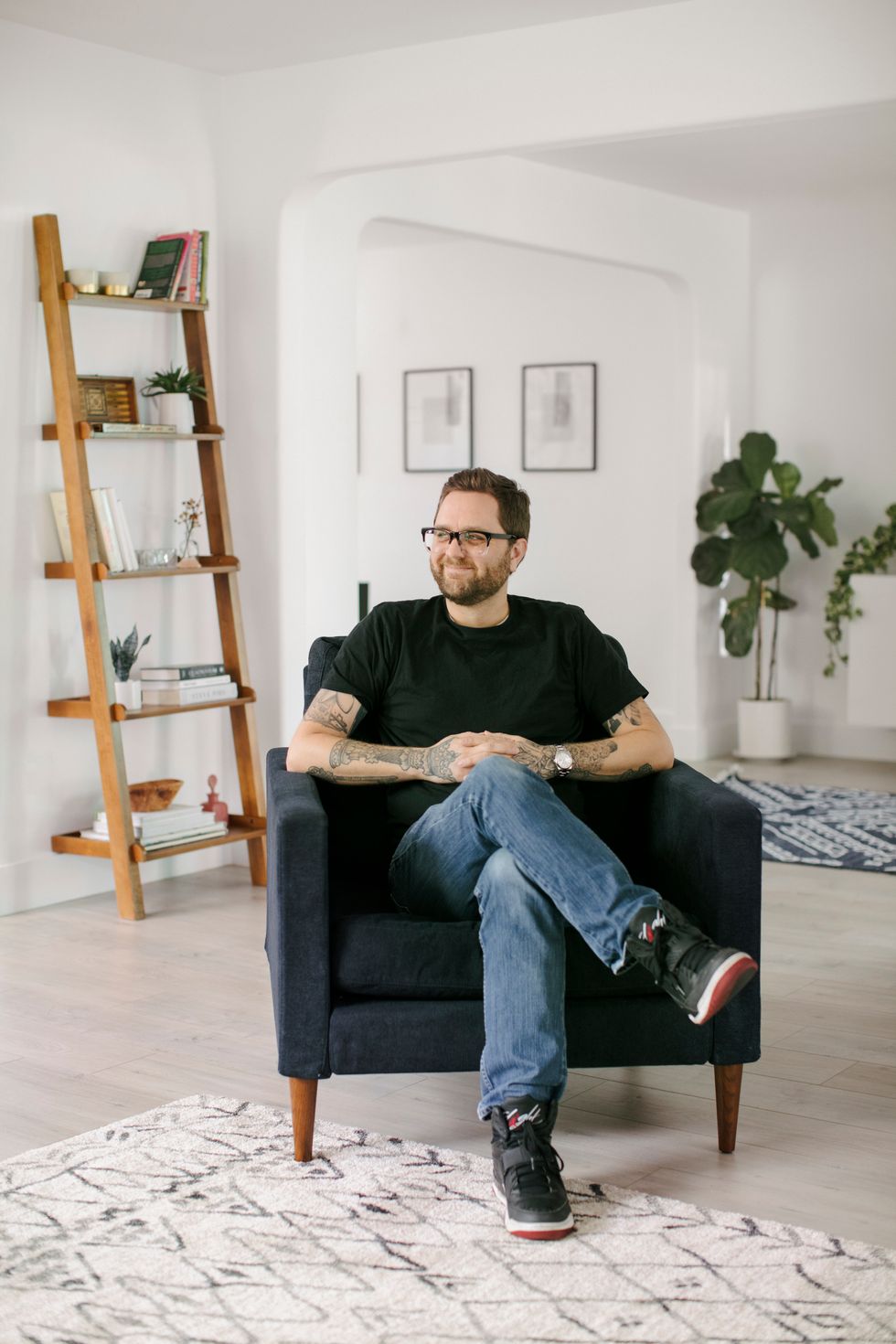Guest Column: Fernish Co-Founder Says He's Taking Every Precaution During COVID-19

Let's call this the 'lede' and not bury it: I'm a co-founder, father, partner, community member and I've got a lot going on in my head right now. This piece serves as a rapid-fire, stream of consciousness glimpse into my mental montage, which at times shifts swiftly from Boschian fear-scapes, to gallows humor, to intentional positivity to give the vagus nerve the stimulus it needs right now.
 Courtesy of Fernish
Courtesy of FernishHowever, a bit of a necessary preamble here to know prior to digging in further: I'm co-founder of a company in L.A. — that also operates in the original U.S. coronavirus hotspot, Seattle — called Fernish, a full-service premium furniture rental company. It's important to share this bit of background:
A) Much like all VC-backed startups we're always thinking about the next raise, managing cash flow closely, and doing everything we can to retain staff,
B) That we have in-the-field delivery staff that are still entering customers' houses and apartment buildings despite possible exposure and accompanying risk, and
C) Our business has the "fun" and complexity of any bits+atoms business, including supply chain, logistics infrastructure, fixed capital costs associated with things like warehousing, and other upstream ramifications.
Also, much of what "I" am thinking about and "I" am doing are a direct reflection of my co-founder, Michael Barlow, our COO, Kristin Smith, and the rest of our team at large. And with that, we can begin…
What I'm thinking about:
- Our team. I'm spending probably 50% of my mental space thinking about the Fernish team. That might be an underestimation given 200% startup capacity. Questions like: Will our team even be able to continue to operate legally? Will there be an unexpected change to businesses designated as "essential services" that'll force us to shut down our warehouses or delivery services? Will we continue to receive demand for our services while people are hunkered down in order to justify the variable cost of contracted labor (i.e. keeping those non-Fernish employees we think of as our "team" employed)? Will our team be safe—both physically and psychologically—during these unprecedented times? Will our team have confidence that we know WTF we're even doing? (That last one is standard founder imposter syndrome that's only exacerbated given current circumstances.) Can we continue to live by our operating values—the values that should reflect who we are in thick and thin?
- Our customers. What can we do for them differently in terms of the service we're offering? What new product selection should we consider for them to meet their (temporarily?) changing needs? What sort of financial impact will "stay in place" orders have on their lives, their livelihood, and—not to be crass in any way, but—their ability to continue paying Fernish for their monthly subscription plans? And on a longer horizon, will they think of their home's differently and how might that interact their relationship with Fernish?
- Reading: Part 1: Biz Lit as a Tool. I'm reading. A lot. I've always read a lot, but I've found myself circling back to classics like Ben Horowitz's "The Hard Thing About Hard Things", his original "Peacetime CEO/Wartime CEO" blog post, Andy Grove's "High Output Management" (which is my all-time favorite business book). But I'm also reading new pieces by the likes of NfX including "28 Moves to Survive (& Thrive) in a Downturn" and dot.LA Chairman (and amazing operator) Spencer Rascoff's post "Advice to CEOs on Their Upcoming Layoffs — From Someone Who Has Done it Before". I have a strong preference and bias for sober, clear, and practical advice from those who have been there and done that, hence Ben and Spencer's posts speaking to me. Whether facing these choices directly or just to have back-of-pocket for "what if" scenario planning, these are great tools for steeling yourself mentally, and honing your empathetic muscles a bit in an anticipatory fashion.
- Reading: Part 2: The News as Direct Input to Operations. Much like everyone else, I'm following COVID news closely, but especially—much like my founder and operator peers—I'm following news out of Capitol Hill and state/county/municipal governments vis-a-vis fiscal stimulus packages, ever-changing "safer-at-home" order details, and further things that directly impact Fernish and offer us a lifeline via credit facilities, tax deferments, grants, and anything else that helps Fernish extend our runway AND has an impact on how we keep our front-line staff as safe as possible (i.e. Team Fernish delivery drivers and warehouse workers). Thank GOD that congress just managed to pass a multi-trillion dollar COVID financial package.
What I (and Fernish executive team) are doing:
- For our team. We've tightened all of the safety guidelines, secured all the cleaning and protective gear we can responsibly hold (as yes, we're being mindful of the health community needing this same gear), and are proactively reaching out to customers in advance of delivery to verify that no one in the destination household is symptomatic (while simultaneously being aware that COVID can be transmitted even by asymptomatic carriers). And for our now-distributed HQ team WFH, we're holding more virtual events (virtual taco Tuesday, virtual happy hour…but honestly our team is "caring for the communal" and arranging these from the bottom up), checking in daily over Slack on mental/physical health, and trying to make the teams as productive and happy as they can be in their "new" surroundings. And we're discussing all of this daily as an exec team as part of a recurring COVID war room (and yes, fighting this epidemic really does feel like war, even for us who aren't front-line medical professionals). So, succinctly: safety and security.
- For our customers. Like many of our delivery peers, you can expect to see options for "no contact delivery"—win, win for the customer and our team. We're also beefing up office furniture for the WFH masses that weren't quite set up for this to be an everyday thing for months. We're working out how to manage the inevitable financial hardships of our customers in the face of unexpected downtime due to sickness or unemployment due to business closures or at least furloughs. We're showing empathy in all of our communication—this is not new, but we're doubling down here as hardship runs rampant. Not surprisingly, these initiatives, much like those for our team, are also about safety and security.
- For our community. We're giving our time to our peers, as we always have, to contemplate all sorts of scenarios and how to manage that in the context of our businesses. We're giving our money to charitable effortsthat will ideally help those in the communities within which we operate. We're participating in forums to share thoughts, emotions, and posting things like this…that make us vulnerable, but also allow us to connect and allow others to feel isolated within the constraints of social distancing.
- For our company. As any fiscally responsible business should in a time of market volatility and economic uncertainty at a global level, you best believe we're finding opportunities to tighten belts, including filing SBA loans (thanks to new provisions in the recently passed legislation—see a great breakdown in tools for VC-backed startups in this NVCA post), revisiting vendor pricing & relationships (knowing those who work with us now will be good long-term partners), fundraising (but, really, what startup isn't always fundraising?), revisiting any and all variable costs to see what additional burn we can eek out (no sacred cows when you're at war!). Startups aim to survive and thrive in scarcity, so to a certain extent this is just more testing of our mettle, but damn if this isn't really pushing the startup community to our creative financial limits!
- For the future. And yet. And yet, despite all of the arguably defensive and short-term efforts above, we're still making time to think about how we might "gain ground" now, or at least tee up strategic efforts through the blessing of today's unique vantage. We're a funny bunch, entrepreneurs, and right now our delusions are coming in handy, for sure.
For lack of a pithy summary, I simply want to sign off by saying that I hope we all find collective safety and security, and solidarity in this shared crisis, sooner than later.
Lucas Dickey is the chief product officer and co-founder of the furniture rental service, Fernish.
- Coronavirus Impact on SoCal Business Becomes More Apparent ... ›
- How Should L.A. Businesses Prepare For Coronavirus? - dot.LA ›
- Here Are the Investors Still Writing Checks During the Coronavirus ... ›
- Coronavirus Could Push the U.S. Into a Recession, Expert Says ... ›
- Here's How Curative, Inc, Plans to Roll Out Coronavirus Testing to U.S. Cities - dot.LA ›
- Fernish Raises $15M As America Redecorates Under Quarantine - dot.LA ›
- Fernish Raises $15M As America Redecorates Under Quarantine - dot.LA ›



 Image Source: Valar Atomics
Image Source: Valar Atomics Image Source: Waymo
Image Source: Waymo Image Source: Apple
Image Source: Apple
